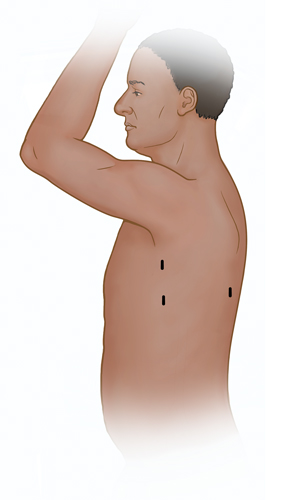Thoracoscopy
Thoracoscopy is also called video-assisted thoracoscopy surgery (VATS). It’s often used to repair a collapsed lung. It’s also used to take biopsy samples from lymph nodes, lung tissue, the chest wall, or the lining of the lung (pleura). It's also used to stage a mass in the lung. This is to find out if a mass is cancer and if it has spread. Or it may be needed to drain fluid from around the lungs. Or to look for causes of lung problems.
An entire lobe or entire lung can be removed during this surgery. During this surgery, your surgeon can look into your chest. They will then do procedures through small incisions in the chest wall. Sometimes a thoracoscopy can’t be used for the whole surgery. In this case, you may need an open surgery (thoracotomy).
 |
| Possible incision sites for thoracoscopy. |
Preparing for your surgery
-
Ask any questions you have about the surgery.
-
Have blood tests or other tests, such as an X-ray or electrocardiogram that your doctor orders.
-
If you smoke, stop right away to reduce complications from the surgery.
-
Tell your healthcare provider about any medicines you’re taking. This includes aspirin. Ask if you should stop any of them, such as blood thinners. Also ask when they should be stopped. Ask which to take on the day of your surgery. Mention any vitamins, herbs, or other supplements you take.
-
Follow any directions you are given for not eating or drinking before surgery.
-
Arrive at the hospital on time the day of your surgery.
The surgery
-
The anesthesiologist gives you general anesthesia. This lets you sleep and be free from pain during surgery. Once you’re asleep, you’ll be moved to lie on your side.
-
The surgeon will make several small incisions in your side.
-
The surgeon puts a thin, flexible tube (catheter) through one of the incisions. It contains a tiny camera. This camera allows the surgeon to view your lungs on a video monitor. The surgeon puts surgical tools through the other incisions.
-
When the procedure is done, the surgeon may put one or more tubes in your chest temporarily. These drain fluid and air. The incisions are then closed with sutures or staples.
Risks and possible complications
VATS is generally safe. But like any surgery, it has a small risk of complications. Complications could include:
-
Wound infection from the cuts (incisions)
-
Air leak through the lung wall. This requires a longer hospital stay or another operation.
-
Problems from anesthesia
-
Poor lung function. In some cases you may need to use a breathing machine (ventilator) long term.
-
Bleeding. This may need to be treated with a blood transfusion.
-
Pain or numbness at the incision site
-
Bruising of the nerves under the ribs (intercostal nerve syndrome). This causes pain at the incision site for several weeks, months, or in some cases, long term.
-
Lung infection (pneumonia)
-
Collapse of the lung or part of it (pneumothorax)
-
The surgery can't be completed as planned and a large incision is used
-
Death
Online Medical Reviewer:
Mary Mancini MD
Online Medical Reviewer:
Ronald Karlin MD
Online Medical Reviewer:
Stacey Wojcik MBA BSN RN
Date Last Reviewed:
7/1/2022
© 2000-2024 The StayWell Company, LLC. All rights reserved. This information is not intended as a substitute for professional medical care. Always follow your healthcare professional's instructions.